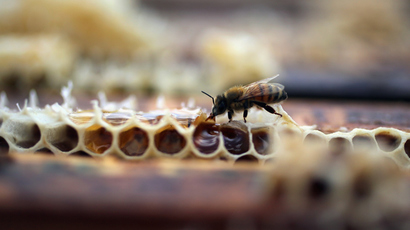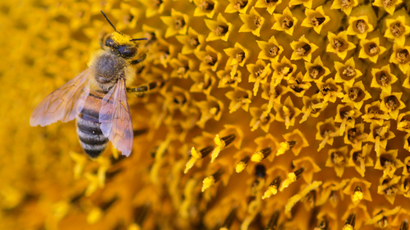Environmentalists sue California for ‘rubber stamping’ use of honeybee-killing pesticides

Three environmental and food safety nonprofits are suing the California Department of Pesticide Regulation (DPR) over its approval of insecticides linked to the massive die-off of honeybees in the state, saying the agency violated state laws by doing so.
The Pesticide Action Network North America, the Center for Food Safety, and Beyond Pesticides joined together to file the suit in a California Superior Court. They point to current research blaming the cause of Colony Collapse Disorder (CCD), the disease killing off honeybees and threatening pollination of the world’s crops, on two popular insecticides.
The two products, clothianidin and imidacloprid, are both types of neonicotinoids. Another study found that bees exposed to "field-realistic" doses of neonicotinoid insecticides gather less than half the pollen that they normally do, dooming their young to starvation.
Neonicotinoids were developed in the 1990s to boost yields of staple crops such as corn, but they are also widely used on annual and perennial plants in lawns and gardens. Researchers believe the neonicotinoids are causing some kind of unknown biological mechanism in bees that in turn leads to CCD.
"In 2006, honeybees began dying at unprecedented rates," the groups stated in their 46-page complaint.
"Today, whether honeybees will survive and recover in America is uncertain, and so we have reached the point of agricultural and environmental crisis. About one-third of the food we eat - and an even greater proportion of our overall nutrition - comes from plants that will not make fruit or seed unless they are pollinated by a bee. The crisis is especially acute in California, because we are the largest producer of crops that require honeybees for pollination, including our most valuable crop: almonds."
CCD has killed tens of millions of honeybees in the US, with annual death rates of about 30 percent. Since 2006, around 10 million beehives at an average value of $200 each have been lost, according to a 2013 US Department of Agriculture study. Honeybees pollinate more than 100 US crops – including apples, zucchinis, avocados, and plums – that are worth more than $200 billion a year. CCD is threatening the existence of those crops.
“None of this is news” to the DPR, the suit claims. In 2009, the agency initiated a “reevaluation” of the use of neonicotinoids in the state. “Over five years later, DPR’s reevalution remains ongoing with no end in sight, and DPR has taken no significant steps to protect honeybees. And DPR’s foot dragging is only part of the problem.”
“Pending its reevaluation, DPR has not hesitated to make the existing problem worse by expanding the use of neonicotinoids without any meaningful analysis of the impact to bees or feasible alternatives, in violation of the California Environmental Quality Act (CEQA) and other laws,” the court documents said. “DPR’s actions are consistent with the agency’s illegal pattern and practice of rubber-stamping applications to approve new pesticides without first complying with laws enacted to ensure they are safe.”
The lawsuit focuses on the DPR’s mid-June decision to expand the use of two neonicotinoids - Venom Insecticide and Dinotefuran 20SG. The group of petitioners is asking the court to put a hold on the approval of the two insecticides until the reevaluation is complete.
The DPR has approved 15 new neonicotinoid products or expanded uses for existing products since 2012. In the agency’s approval reports, the DPR failed to analyze the direct and cumulative impacts that approving these pesticides would have on honeybees and other pollinating insects in light of the agency's past and future decisions regarding neonicotinioid use, the lawsuit says.
The European Commission adopted a two-year moratorium on the use of three neonicotinoid pesticides in 2013. Scientists are using those two years to determine whether the ban helps stop declines in bee populations, after which the restriction may be reviewed. US officials have stated that they don’t have enough evidence to ban neonicotinoids.
The Center for Food Safety filed a legal brief in December in support of a lawsuit backed by many organizations that seeks a reversal of the US Environmental Protection Agency’s (EPA) May 2013 decision to approve sulfoxaflor, a neonicotinoid. That lawsuit is the first to invoke the US Endangered Species Act to protect bees, claiming the EPA violated the act by not sufficiently considering the impact of pesticides on honeybees and other imperiled wildlife categorized as threatened or endangered under federal law.














